Located in southwestern Africa, Namibia boasts a well-developed infrastructure, some of the best tourist facilities in Africa, and an impressive list of breathtaking natural wonders. Visitors can explore the capital of Windhoek and discover the lovely coastal town of Swakopmund boasting remnants of the country’s German influence, reflected in the architecture, culture, cuisine and the annual Oktoberfest celebrations. To properly appreciate this extraordinary country, you will have to venture out of the cities to explore the remarkable natural landscapes Namibia has to offer. These include: the impressive Fish River Canyon; the vast Etosha National Park teeming with abundant wildlife, such as lions, desert-adapted elephants and the Hartmann's Mountain Zebra; the hauntingly beautiful Kalahari Desert; and of course the Namib Desert stretching for over 2000 km along the magnificent Atlantic Coast. Namibia is an ideal destination for travellers seeking an unforgettable African experience in a uniquely beautiful untamed wilderness.
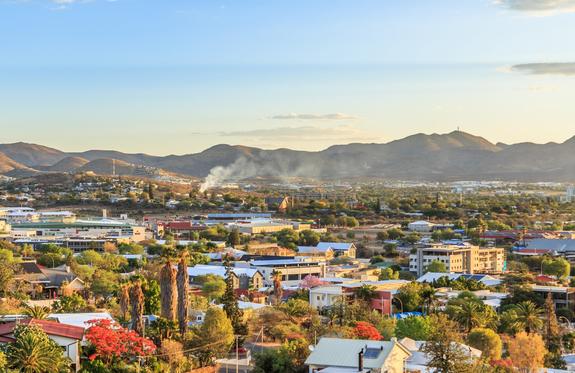
Windhoek is the capital of Namibia, located in the central highlands of the country. South of the city, the sprawling Heroes' Acre war memorial commemorates Namibia's independence in 1990. On a hill in the city center stands the Old Fort, dating back to the 1890s, which was a former military headquarters with historical exhibits, and the Independence Memorial Museum. Colonial influences are visible in nearby buildings such as the Lutheran Christ Church made of sandstone, as well as in the Victorian buildings lining the streets of Windhoek.
THINGS TO DO
- National Museum Namibia (www.museums.com.na/museums/ windhoek/national-museum-of-namibia)
- Independence Memorial Museums (www.museumscom.na/ museums/wind-hoek/independence-museum)
- Visit the Christ Church
- Tour through the Katutura Township (www.mwiyatours.com)
UNSERE RESTAURANT TIPPS
- Joe's Beerhouse (www.joesbeerhouse.com)
- Daisho Sushibar (www.daishosushibar.com/menu)
- ButcherBlock (www.butcherblocksteakhouse.com)
- Leo’s at the Castle (www.heinitzburg.com)
TIPS
Stellenbosch Wine Bar & Bistro: The bistro-style menu showcases the fresh and diverse flavors of Namibia. The focus is on prime Namibian cuts of meat, perfectly grilled over an open flame, accompanied by a selection of delicious homemade sauces and sides. Complete your meal with a quality wine from the excellent wine list.
Tel.: +264 61 309 141 \ Web.: www.thestellenboschwinebar.com
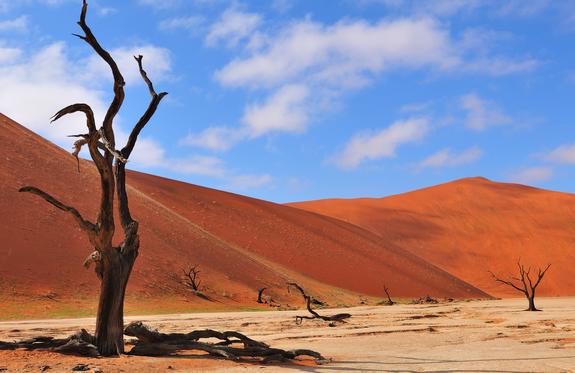
The Sossusvlei region lies in the heart of the breathtaking Namib Desert and is renowned for its extraordinary beauty and majestic landscapes. Sossusvlei is a dry clay pan surrounded by massive sand dunes, including the famous Dune 45, which is among the highest in the world. The landscape of Sossusvlei is characterized by impressive diversity. The red-orange sand dunes create a striking contrast with the blue sky and the white clay floors. The play of light and shadow throughout the day produces spectacular color displays, especially at sunrise and sunset.
In addition to Dune 45, the Sossusvlei region features other unique natural attractions such as Dead Vlei, a dried-up clay pan with petrified tree trunks that have been lying in the desert sun for centuries. This surreal backdrop offers photographers and visitors unparalleled opportunities to capture the beauty and tranquility of the desert. The Sossusvlei region is a paradise for nature lovers and adventurers. Numerous activities are available, including dune hikes, photo tours, stargazing, and even hot air balloon rides to explore the impressive landscape from a bird's-eye view.
Sesriem is a small settlement that serves as the gateway to the Sossusvlei region and the Namib-Naukluft National Park. It is located about 65 kilometers southwest of Solitaire and is a popular starting point for visitors wishing to explore the spectacular sand dunes and desert landscapes of the area. The name "Sesriem" refers to the six leather straps that early settlers tied together to draw water from the deep gorges surrounding the Tsauchab River. These gorges are now known as Sesriem Canyon, offering a fascinating sight with high rock walls and a dried-up riverbed.
Sesriem is also known for its picturesque campsites, lodges, and guest farms, which provide comfortable accommodations amid the desert landscape. Many of these accommodations organize guided tours to nearby attractions, including the Sossusvlei dunes, Dead Vlei, and Sesriem Canyon.
WILDLIFE IN THE REGION: Desert Elephants | Oryx Antelopes (Gemsbok) | Springbok | Ostriches | Desert Lions | Jackals | Geckos & Lizards | Snakes

As there is no accommodation at Sossusvlei, visitors to this desert wilderness are likely to end up staying at Sesriem, 65 kilometres away, where camps and lodges serve as a base from which to explore the dunes. Sesriem Canyon, a deep chasm carved through the rocks by water, is a striking natural feature of the area that is best explored on foot. Stony walls rise up sharply on both sides of the canyon, while birds roost in its crags and lizards dart along the ledges. The canyon’s name was coined when early settlers used it as a water source, using six lengths of leather (‘ses riem – six thongs) tied together to lower buckets into the water at the base of canyon.)
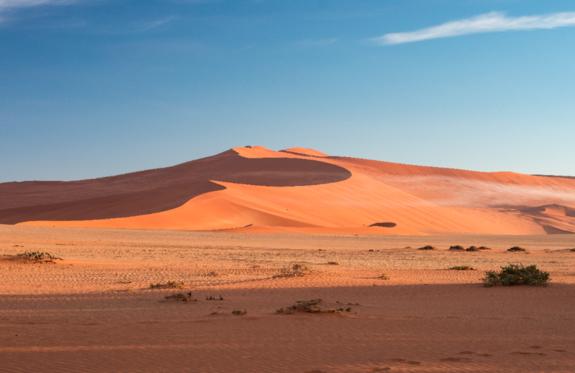
The highest dunes in the world, the rugged Naukluft Mountains, the inhospitable west coast, and endless karst plains—Namibia's most spectacular landscapes are found in the Namib-Naukluft Park, Africa's largest nature reserve. The park stretches from the Skeleton Coast in the north to the Diamond Barrier Area in the south and borders the private Namib Rand Nature Reserve in the east.
The Namib Desert runs over 2,500 kilometers along the Atlantic Ocean from Angola through Namibia to South Africa, encompassing both the world's oldest desert, the Namib Desert, and the impressive Naukluft Mountains. It offers a unique landscape, challenging hiking trails, diverse wildlife, and a wealth of bird species.
The orange sand is a clear indicator of the desert's age; over millions of years, the iron ions in the sand have oxidized into iron oxide, giving it its distinctive color. The sand dunes tower up to 300 meters high, and the constant southwest wind ensures they continually take on new formations and are blown further inland.
The climatic conditions, with temperatures up to 48°C and almost no rainfall, make the area nearly uninhabitable. Rain falls only between February and March, with an annual total of just 63 millimeters; the necessary moisture usually comes from fog off the Atlantic Ocean.

The NamibRand Nature Reserve stretches over an area of approximately 200,000 hectares in the southern part of the Namib Desert. It is a place of remarkable beauty, renowned for its fascinating landscapes and rich wildlife. Established in 1984 by Namibian landowners who recognized the importance of protecting the unique desert landscape and its diverse wildlife, the reserve stands as an outstanding example of sustainable conservation and communal development.
One of the most striking features of the NamibRand Nature Reserve is its majestic sand dunes, which stretch across the land, creating a surreal backdrop. These high, constantly shifting dunes often appear in various shades of red, orange, and gold, offering a breathtaking sight at sunrise and sunset. The reserve is home to an impressive variety of wildlife adapted to the harsh desert conditions. Cheetahs, desert elephants, giraffes, oryx antelopes, springboks, and many other species find their habitat here. Wildlife viewing in the NamibRand Nature Reserve is a special experience, as the animals move freely and undisturbed in their natural environment.
Another highlight of the reserve is the night sky. With minimal light pollution, the NamibRand Nature Reserve provides an incredible opportunity to admire the clear night sky with its countless twinkling stars. It is a paradise for stargazers and astronomy enthusiasts who wish to experience the beauty of the universe in all its glory.
Visitors to the NamibRand Nature Reserve can participate in a variety of activities. Guided walks take guests through the fascinating desert landscape, allowing them to discover the unique flora and fauna of the reserve. Game drives offer exciting wildlife encounters and the chance to capture these fascinating moments with a camera. The NamibRand Nature Reserve is a place of unparalleled beauty and rugged, captivating wilderness, enchanting adventurers and nature lovers alike.

Swakopmund is a charming coastal town and a popular destination for tourists from all over the world. The city blends German colonial architecture with African flair and offers a variety of activities and attractions. Situated on the coast on the edge of the Namib Desert, the city provides a wonderful view of the Atlantic Ocean. The towering sand dunes and rugged coastline offer numerous opportunities for activities such as sandboarding, quad biking, and dune hiking. Swakopmund is also renowned for its excellent restaurants and cafes, where you can enjoy both Namibian and international cuisine. Be sure to taste local specialties made from fresh fish and seafood.
THINGS TO DO
- Dolphin Cruise (mola-namibia.com)
- Tommy’s Living Desert Tour (livingdeserttours.com.na)
- Excursion toWalvis Bay
- Fat Bike Tours (https://www.swakopfatbiketours.com/)
RESTAURANT TIPPS
- The Tug (www.the-tug.com)
- Kücki’s Pub (www.kuckispub.com)
- Jetty 1905 (www.lighthousegroup.com.ca)
- The Wreck Restaurant (www.the-wreck.com)
- Village Cafe (www.villagecafenamibia.com)
OUR TIP
Quad biking with Desert Explorer: Looking for a bit of adrenaline? Then join Desert Explorer on a tour through the fascinating dune landscape around Swakopmund. One to three-hour quad bike tours are offered with experienced guides (www.namibiadesertexplorers.com).

Walvis Bay, originally discovered by Diaz in 1487 and founded by the Cape Dutch in 1793, was later annexed by the British. After Namibia's independence, the deep-sea port remained under South African control until it was returned to Namibia in 1994. Today, the town has around 40,000 residents and is located about 30 km from Swakopmund. Walvis Bay is a bustling town with a modern port and a thriving fishing industry. The salt flats in the area produce 400,000 tons of salt annually.
The town offers several attractions, including a local history museum, the Birdlife Information Centre, and the 1880-built Rhineland Mission Church. One of the most impressive features of Walvis Bay is its large lagoon, home to over 120,000 birds, including flamingos and pelicans. "Dune 7" on the outskirts of town is the highest sand dune in the area and provides a spectacular view at sunrise or sunset.
Walvis Bay also boasts numerous good restaurants, cafés, and bars, as well as comfortable hotels and guesthouses. A highlight of the area is the adventurous trip to Sandwich Harbour, a freshwater lagoon surrounded by dunes. The trip requires a 4x4 vehicle due to the deep sand, and the final stretch must be completed on foot.
THINGS TO DO
- Sandwich Harbour and Topnaar Cultural 4x4 Tour
- Marine Dolphin Cruise: https://www.mola-namibia.com/marine-dolphin-cruise
- Seal Kayaking @ Pelican Point: https://desertdunesdust-tours.com/half-day-tours/

Twyfelfontein, located in Namibia’s Kunene Region, is a site of extraordinary cultural and historical significance. Known for its rich collection of over 2,500 prehistoric rock engravings, Twyfelfontein is one of Africa’s most important archaeological sites and a UNESCO World Heritage site.
Visitors can explore the beautifully preserved petroglyphs depicting animals, humans, and mysterious geometric patterns, thought to have been created by hunter-gatherers over 6,000 years ago. The red sandstone rock formations, set against the backdrop of rugged desert landscapes, add to the region's dramatic natural beauty.
In addition to its archaeological significance, Twyfelfontein offers visitors the chance to see rare desert-adapted wildlife, including elephants, giraffes, and oryxes. Guided tours are available, giving travelers the opportunity to delve deeper into the history and culture of this fascinating area.
Nearby Attractions:
- The Petrified Forest: A unique site with ancient fossilized trees.
- The Organ Pipes: Striking dolerite columns formed by volcanic activity.
- Burnt Mountain: A dark, eerie-looking hill with unusual geological features.
Whether you are a history enthusiast or a nature lover, Twyfelfontein provides a captivating experience that combines the ancient past with the rugged beauty of Namibia's desert wilderness.

Damaraland is renowned for its breathtaking landscape, fascinating wildlife, and rich culture. The region boasts spectacular rock formations, rugged canyons, and vast plains, allowing visitors to experience the unique beauty of the Namib Desert landscape. Damaraland is also home to impressive animal species such as desert elephants, desert lions, and black rhinos. Additionally, there are prehistoric rock engravings and fossils to discover, providing insights into the region's long history. The cultural diversity of Damaraland is evident in the traditional Himba villages, where visitors can learn more about the lifestyle and customs of this fascinating ethnic group.
Khorixas serves as the center of Damaraland, stretching between the Erongo Mountains and the Etosha Pan in the northwest of the country. The name dates back to the era of the "Homelands," and today, Damaraland falls under the administration of the Kunene Region. The area is predominantly inhabited by the Damara people, who, along with the San (Bushmen), are among the oldest inhabitants of Namibia. Their language belongs to the Khoisan dialects, related to the languages of the Nama and San peoples. Khorixas itself, apart from a gas station, some shops, a rest camp, and a lodge, does not offer major highlights. However, the mountainous and rocky region surrounding Khorixas is home to several outstanding natural attractions, such as the Basalt Columns, known as the "Organ Pipes," located a few kilometers from Twyfelfontein, and the "Petrified Forest" with its 300 million-year-old tree trunks.
THINGS TO DO
- Visit the UNESCO World Heritage Site in the Twyfelfontein Rock Engravings Area
- Hiking and trekking tours
- Visit to a traditional Himba village
- Excursion to Spitzkoppe
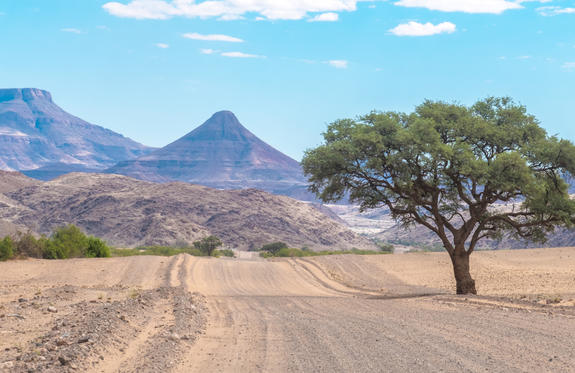
This small town in the Southern Kunene Region of Namibia was once the capital of Damaraland and is home to around 6000 inhabitants, most of whom are from the Damara ethnic group. While the tiny town itself provides travel necessities at the local supermarket, bank, and petrol station, the surrounding area is a nature lover’s paradise with a variety of tourist attractions including the bizarre Welwitschia mirabilis at Burnt Mountain, rare stone formations, the petrified forest, ancient rock engravings and as well as many fascinating geological phenomena (make sure to see the 'Organ Pipes'). Khorixas is the epitome of a Namibian rural town. It marches to a slow African rhythm and its wonderfully friendly locals offer a warm welcome to all guests.

Located just south of the boundary of Etosha National Park in northwestern Namibia, Etosha South makes up the southern region of this wild paradise. The area is comprised of a collection of world class private game reserves. The national park can be accessed via the southern entrance at Andersson’s Gate. Visitors can catch a glimpse of a variety of wildlife including: lion, giraffe, elephant, white and black rhino, and a multitude of plains game. Popular activities include: enjoying an open 4x4 safari with an expert guide, half day or full day drives with the option of a picnic lunch with wine on the full day game drive.
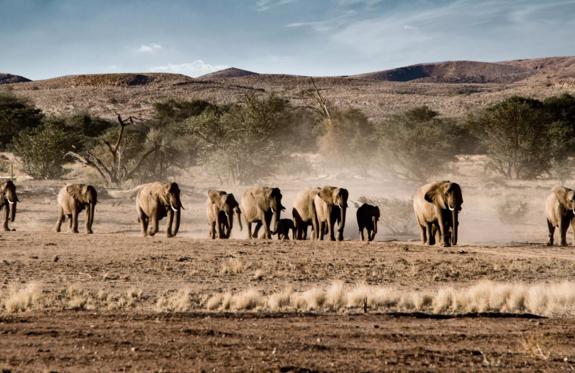
The Etosha National Park is a true paradise for wildlife enthusiasts. Covering an area of approximately 22,000 square kilometers, the park is home to an impressive variety of wildlife. Its main attraction, the Etosha Pan, is an expansive salt pan that offers a unique and fascinating landscape, making it a renowned spot for wildlife observation. Visitors to the Etosha National Park have the privilege of experiencing a wide range of animals in their natural habitat. Here is a list of the most commonly found species in the park:
Elephants | Lions | Black Rhinoceros | White Rhinoceros | Giraffes | Zebras | Oryx | Wildebeests | Impalas | Leopards | Cheetahs | Hyenas | Jackals | Flamingos | Springboks | Hartebeests | Kudus | Pelicans | Hornbills | Eagles | Vultures
These animals roam through savannah-like landscapes, visit waterholes, and provide an impressive spectacle in the Etosha National Park. Herds of elephants pass by, lions rest in the shade, and zebras and giraffes graze. The park offers endless opportunities to observe wildlife in their natural environment. Bird enthusiasts will also be thrilled by the diversity of birdlife, from majestic raptors like eagles and vultures to colorful flamingos in the vast Etosha Pan.
GATES OF THE ETOSHA NATIONAL
There are several entrance gates to the Etosha National Park. In the east lies the Andersson Gate, and in the west, the Galton Gate, named after the explorers Charles Andersson and Francis Galton. The Von Lindequist Gate in the east was named after the governor of German South West Africa, who declared Etosha a protected area in 1907. The Nehale Lya Mpingana Gate near the Andoni Plains is named after a king of the former Ovambo country.
Etosha Trading Post (Southern Entrance Etosha NP): As the name "Trading Post" suggests, the recently opened shop and gas station are places of exchange. The shop offers visitors all the essential groceries, snacks, and souvenirs. The entire building is designed in a historical style, where past and present merge... all located in a strategically perfect location just 10 km from the Andersson Gate, the southern entrance to the national park.

Located in Northwestern Namibia, Etosha East is a protected sanctuary in the eastern part of the world-renowned Etosha National Park, known as one of the most accessible game reserves in Southern Africa. Etosha East boasts vast open plains scattered with semi-arid savannah grasslands dotted with watering holes and secluded bush camps. An impressive 5000-square-kilometre Etosha salt pan makes up a large area of the eastern side of the park and can even be seen from space. This remote area teems with abundant wildlife such as lions, elephants, black rhinos and giraffes, as well as a variety of birdlife featuring flamingos, ostriches, eagles, hornbills, and owls.




